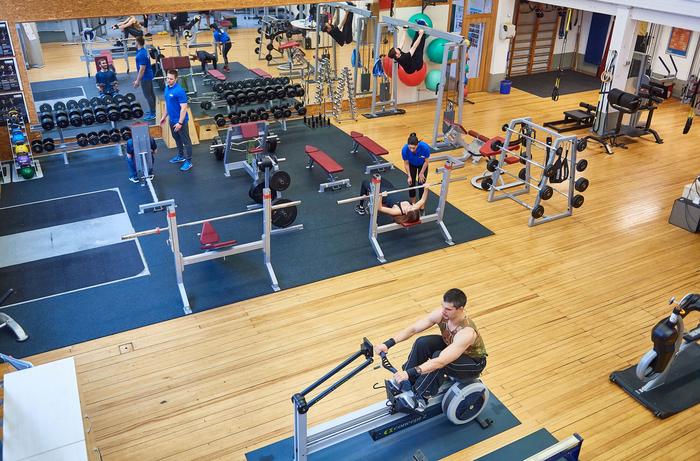The elimination of damaged cell components is essential for the maintenance of the body’s tissues and organs. An international research team led by the University of Bonn has made significant findings on mechanisms for the clearing of cellular wastes, showing that strength training activates such mechanisms. The findings could form the basis for new therapies for heart failure and nerve diseases, and even afford benefits for manned space missions. A corresponding article has been published in the latest issue of the journal Current Biology. EMBARGOED: Do not publish until 5 pm CEST on August, 23rd!

Credit: Photo: Volker Lannert / University of Bonn
The elimination of damaged cell components is essential for the maintenance of the body’s tissues and organs. An international research team led by the University of Bonn has made significant findings on mechanisms for the clearing of cellular wastes, showing that strength training activates such mechanisms. The findings could form the basis for new therapies for heart failure and nerve diseases, and even afford benefits for manned space missions. A corresponding article has been published in the latest issue of the journal Current Biology. EMBARGOED: Do not publish until 5 pm CEST on August, 23rd!
Muscles and nerves are long-lasting, high-performance organs whose cellular components are subject to constant wear and tear. The protein BAG3 plays a critical role in the elimination of damaged components, identifying these and ensuring that they are enclosed by cellular membranes to form an “autophagosome”. Autophagosomes are like a garbage bag in which cellular waste is collected for later shredding and recycling. The research team led by Professor Jörg Höhfeld of the University of Bonn Institute of Cell Biology has shown that strength training activates BAG3 in the muscles. This has important ramifications for cellular waste disposal because BAG3 has to be activated to efficiently bind damaged cell components and promote membrane envelopment. An active elimination or clearing system is essential for the long-term preservation of muscle tissues. “Impairment of the BAG3 system does indeed cause swiftly progressing muscle weakness in children as well as heart failure—one of the most common causes of death in industrialized Western nations,” Professor Höhfeld explains.
Important implications for sports training and physical therapy
The study was conducted with significant involvement by sports physiologists of German Sport University Cologne and the University of Hildesheim. Professor Sebastian Gehlert of Hildesheim emphasizes how important the findings are: “We now know what intensity level of strength training it takes to activate the BAG3 system, so we can optimize training programs for top athletes and help physical therapy patients build muscle better.” Professor Gehlert also makes use of these findings to support members of the German Olympic team.
Necessary for the muscles … and more
The BAG3 system is not only active in the muscles. Mutations in BAG3 can lead to a nerve disease known as Charcot-Marie-Tooth syndrome (named after the discovering scientist). The disease cause nerve fibers in the arms and legs to die off, leaving the individual unable to move his or her hands or feet. By studying cells from sufferers, the research team has now shown that certain manifestations of the syndrome cause faulty regulation of BAG3 elimination processes. The findings demonstrate the far-reaching significance of this system for tissue preservation.
Unexpected regulation pointing the way to new therapies
In analyzing BAG3 activation more closely, the researchers were surprised at what they observed. “Many cell proteins are activated by the attachment of phosphate groups in a process known as phosphorylation. With BAG3, however, the process is reversed,” explains Professor Jörg Höhfeld, also a member of the Transdisciplinary Research Area (TRA) Life and Health at the University of Bonn, “BAG3 is phosphorylated in resting muscles, and the phosphate groups are removed during activation.” At this point, phosphatases become the main focus of interest—the enzymes that remove the phosphate groups. To identify the phosphatases that activate BAG3, Höhfeld is collaborating with chemist and cell biologist Professor Maja Köhn of the University of Freiburg. “Identifying the phosphatases involved is a key step,” she relates, “so we can pursue the development of substances potentially able to influence BAG3 activation in the body.” The research may open up new therapeutic possibilities for muscle weakness, heart failure and nerve diseases.
Relevant for space travel
Work on the BAG3 system is supported by the Deutsche Forschungsgemeinschaft (German Research Foundation) through a research unit headed by Prof. Höhfeld. In addition, Höhfeld receives funds from the German Space Agency as the research is of interest for purposes of manned space missions. Professor Höhfeld points out: “BAG3 is activated under mechanical force. But what happens if mechanical stimulation does not take place? In astronauts living in a weightless environment, for example, or immobilized intensive care patients on ventilation?” In such cases, the lack of mechanical stimulation rapidly leads to muscle atrophy, the cause of which Höhfeld ascribes at least in part to the non-activation of BAG3. Drugs developed to activate BAG3 might help in such situations, he believes, which is why Höhfeld’s team is preparing experiments to be conducted on board of the International Space Station (ISS). BAG3 research thus could in fact help us reach Mars someday.
Institutions involved and funding secured
The University of Bonn’s partners in this study are the University of Freiburg, German Sport University, Forschungszentrum Jülich, the University of Antwerp and the University of Hildesheim. The work is co-funded by the German Research Foundation and the German Space Agency, part of the German Aerospace Center.
Journal
Current Biology
Article Title
Force-induced dephosphorylation activates the cochaperone BAG3 to coordinate protein homeostasis and membrane traffic
Article Publication Date
23-Aug-2024



